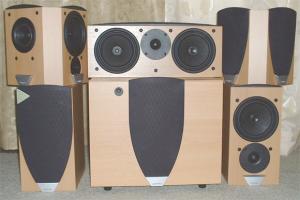Jamo E 800PDD Surround Sound Speaker System
|
Introduction
Jamo, a Danish speaker company, was founded in 1968, and, over the years, has become one of the most successful speaker companies in the world. It is, of course, especially big in Europe, and I first discovered Jamo when I had an academic fellowship in the Netherlands about 13 years ago. I also had a chance to listen to some of the budget Jamo speakers then, which I thought sounded pretty good. But my most important recollection of Jamo was how wide its product range was. You pretty much could find a set of Jamo speakers to fit whatever your budget or taste was.
Many years have passed, and it seems that the tradition of Jamo catering to a wide range of customer�s budget and taste is still alive and well. This is obvious from the company�s current mission to help the customer find the best individual sound solution, which I think is a very sensible approach. Personal taste affects what one considers as "good", and rather than the company deciding what "good sound" is, Jamo tries to supply a solution to accommodate a wide range of listening needs and preferences. If you want a throbbing, pounding bass, Jamo has it. If you want detailed sound, to be played at modest volume, Jamo has it.
To achieve this mission, Jamo invented the so-called SoundGuide tool to make the speaker selection process easier for the consumer. The guide is based on one�s answers to basic questions such as how big the listening room is and what kind of sound characteristics is preferred.
The SoundGuide starts with the size of the room, where the speakers are going to be used, and whether smaller or larger than 250 square feet (the ceiling is assumed to have an average height of 10 ft). The next step is to determine speakers based on the desired sound characteristics. In this regard, the guide divides the sound characteristics into three: detailed sound (for music with special focus on detail like classical or jazz), all-around sound (for a wide range of music), and powerful bass sound (for modern music with special focus on bass like techno and hard rock). Once you determine the room size and the desired sound characteristics, you have narrowed down the list of speakers to those that are appropriate for your needs. You can then choose, from this list, the speakers that will fit your budget.
The Jamo speaker system reviewed here is the E 800PDD package, which according to the guide is intended for use in small listening rooms (less than 250 square feet) and for detailed sound taste. It is a 5.1 speaker system with a pair of bookshelf speakers (E 800), a center channel speaker (E 8CEN), a pair of small surround speakers (E 8SUR), and a powered subwoofer (E 8SUB). The total retail price of the E 800PDD system is $1799, which put it within what I would consider as a budget speaker system (below $2000).
Now let�s look at what we�ve got here.
Features
The E 800 bookshelf speaker is a two-way bass-reflex type with 5 � inch mineral/paper woofer and 1 inch fabric dome tweeter. The speaker has a rear port, below the five-way bi-wireable speaker terminals. In the E 800PDD package, the E 800s are the front left and right speakers. The E 8ADD ensemble (E 8CEN, E 8SUR, and E 8SUB) completes the home theater system package.
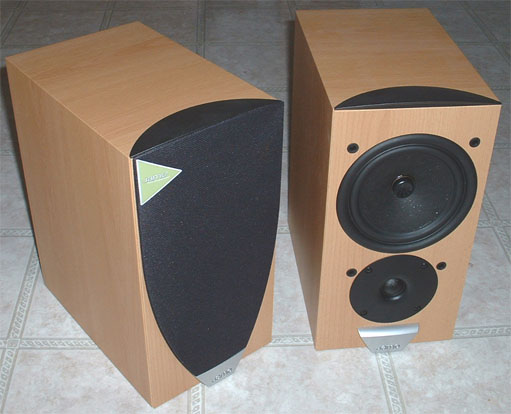
The E 8CEN center channel speaker is also a rear-ported two-way bass-reflex system employing two woofers and a tweeter, which are of the same type as the ones found in the E 800. This speaker can be put on top of your television or hung on the wall (hanging brackets are provided).
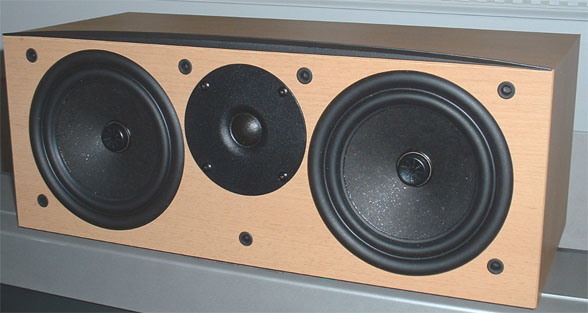
The E 8SUR surround speaker is a three-way acoustic-suspension design with a 5 � inch woofer, a 3 � inch midrange and 1 inch tweeter. This speaker has two angled front baffles, and the drivers are placed in asymmetrical configuration with the two-way woofer and tweeter on one baffle and midrange on the other. The E 8SUR speakers are meant for hanging on the sidewall at about 6 ft high and slightly behind the listener position. Brackets for hanging the speakers on the wall are provided.
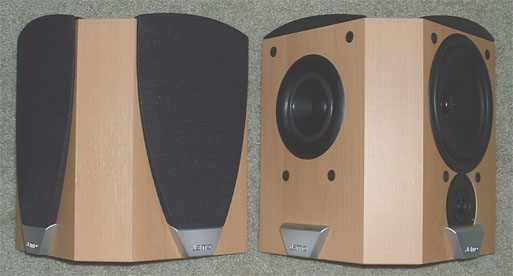
The E 8SUR employs a technique that Jamo calls the Midrange Phase Diffusion (MPD). The technique is closely related to a dipole speaker with its diffuse and spacious sound reproduction, which gives you the impression of really being in the middle of the action. But unlike conventional dipole speakers, which usually have the disadvantage of poor deep bass reproduction due to cancellation between the two closely placed woofers, the MPD technique does not lose any bass information. This is because, in the E 8SUR speaker, the two-way tweeter-woofer system is only �countered� by a single midrange driver operating in the opposite phase. So, in essence, it is only �dipole� in the midrange area where the human ear is best at locating the direction of the sound. As you will see from my comment in the next section, the MPD technique works quite well. Other brands of speakers also employ techniques to limit bass cancellation, by having the dipole function down to, say, 200 Hz, but not below that frequency.
The active subwoofer E 8SUB has a 10 inch down-firing driver with a 200 watt internal amplifier. It is a bass-reflex design with down-facing port next to the driver. Most of the subwoofer controls can be found on the rear panel (crossover, phase, and on/off switch), while the volume control is located in front. Only line-level inputs and outputs are provided. The subwoofer has four short legs, which can be augmented with metal spikes if desired (provided).
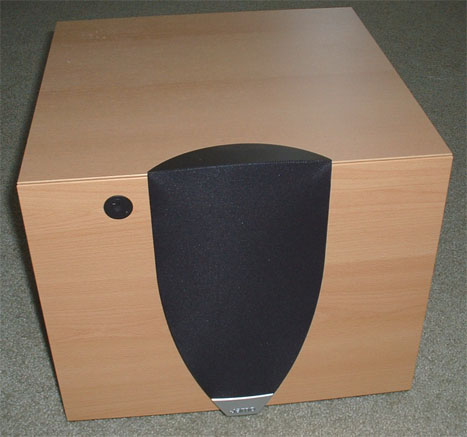


I found the instruction manuals for these speakers to be too simple and incomplete. Jamo tries to put everything in pictures instead of words. I have nothing against this approach, but I do think that words are still needed to give the users complete setup information. For example, on the E 800 manuals, there is no information on the recommended height of the stands to use or whether the speakers should be toed-in. Experienced users should have no problems, but I�m concerned that the lack of such important information could lead to improper setup for inexperienced users.
All the
speakers in the E 800PDD package are very well built and stylishly designed.
The addition of black curving lines on the front top of the speaker cabinets
creates a uniform expression of the package despite the differences in size
and form of the individual speakers. These small outer-cabinet-design
additions really add an elegant impression to the look of the system. The E
800PDD system has three finishes to choose from: cherry, beech, and black
ash. As can be seen from the pictures, the samples reviewed here are in
the beech finish. They are beautiful to look at, and I�m sure they would have a
high spouse acceptance factor.
The Sound of Music
As with any speaker system, I evaluate both the stereo performance of the main speakers and the home theater performance of the whole system. I will start with my impression on the stereo performance of the E 800 speakers. For this test, I put the speakers on 26� stands and toed them in. The speakers and my listening position were equidistant, and they were about 2 ft into the room.
First of all, the sound of these speakers is very different before and after being broken-in, more so than other speakers that I have ever tried. Right out of the box, they sounded somewhat cold and uninvolving. The highs were shrill, and the lows were not extended.
I don�t usually say how speakers sound before they are broken-in, but I feel that I should do it here because there was so much difference before and after. This is intended as a warning, so that if you audition these speakers, make sure you reserve your judgment until the speakers are really broken-in. When the true sound of the speakers had emerged, they were musical and easy to enjoy. I suspect the tweeter and woofer are stiff to begin with, and they loosen up as they are used.
The balance of the E 800 speakers was slightly towards the warm side. The highs were quite smooth and extended, although a little subdued. There was never an impression of being bright. The bass was pretty good and relatively strong for speakers of their size. Midrange presentation of the E 800 was sweet and detailed. On vocals, the presentation was quite natural, although there was a slight trace of nasality. This, however, was only noticeable on some recordings and not too serious so as to get in the way of the enjoyment of the speakers.
The real strong point of the E 800 is on imaging and soundstage, which were admirable, with a little laid back presentation. In these departments, I consider these speakers to be above average in their class. With good recordings, the image created by the speakers bloomed beyond the speakers� boundary with convincing depth. I wouldn�t be surprised if someone bought these speakers just for this very aspect alone.
The E 800s are very good in producing details in music, but these are not speakers for lovers of loud rock or hip hop music. Don�t get me wrong, they are fine for playing any type of music, but not at very loud volume. Pushed too hard, they will sound strained and colored, and the bass especially becomes boxy. To be fair, I should mention that such limitation is common for many other small bookshelf speakers. Also Jamo�s SoundGuide has made it clear that these speakers are optimized for small rooms, which means they are not designed to be driven too hard.
I should
also mention that the speaker grilles on the E 800PDD system are not
sound-transparent enough. This is especially noticeable on the E 800
speakers in a two-channel application. Maybe it�s just personal, but I felt
the sound was a bit muddy with the grilles on. For critical evaluation, I
prefer listening without the grilles.
The Sound of Movies
In a home theater application, the E 800PDD speaker system offers well-balanced all around performance. Of all the members of the E 800PDD system, the E 8SUR surround speakers are my favorites. In short, they are great surround speakers. In creating the ambience sound, they just disappeared and left me with a realistic sound envelopment. They were capable of producing localizable rear effects too when called for.
The E 8CEN center channel speaker is timbre-matched nicely with the E 800 speakers, creating seamless lateral sound transition when it is called for. The slight warmth in its sound character (similar to the E 800) actually tames some of the over-brightness that is often found in movie soundtracks, which is desirable. The level of dialog intelligibility produced by this speaker is good but a tad short from excellent, due to the slight boxiness that is sometimes noticeable in the character of the sound.
The E 8SUB
can be considered small and light in today�s subwoofer world, but its
performance belies its size. It was quite capable of producing tuneful and authoritative
bass down to about 30 Hz. In terms of level of output and extension, the E
8SUB won�t beat the big boys of subwoofers out there, but for a small
subwoofer, its performance is very respectable. Whether producing bass from
explosion scenes or from music, it did not disappoint me.
Conclusions
Despite some minor flaws that I observed during my evaluation, the Jamo E 800PDD speaker system has a lot to like. Nothing in this world is perfect, but the E 800PPD's strengths definitely make up for any weaknesses. The E 800PDD system is equally adept for two-channel and for home-theater applications. If you are looking for a below $2000 speaker system and if you are into the look of the speakers as much as into their performance, then you need to check this system out. Overall, the E 800PDD system offers stylish looks and balanced performance that I am sure will satisfy many music and home theater aficionados.
Associated Review Equipment
CD Player: Shanling CD-S100
Preamplifier: Adcom GFP-750, B&K Reference 20
Amplifier: ATI AT1505
DVD Player: Toshiba SD-2800
Speakers: NHT 2.9, NHT AC-1, NHT SB-2, KEF AV1
Cables: MIT Terminator 4 interconnects, Cardas Crosslink speaker cables, MIT
Terminator 2 speaker cables.
- Yongki Go -
|
� Copyright 2003 Secrets of
Home Theater & High Fidelity |
![]()

